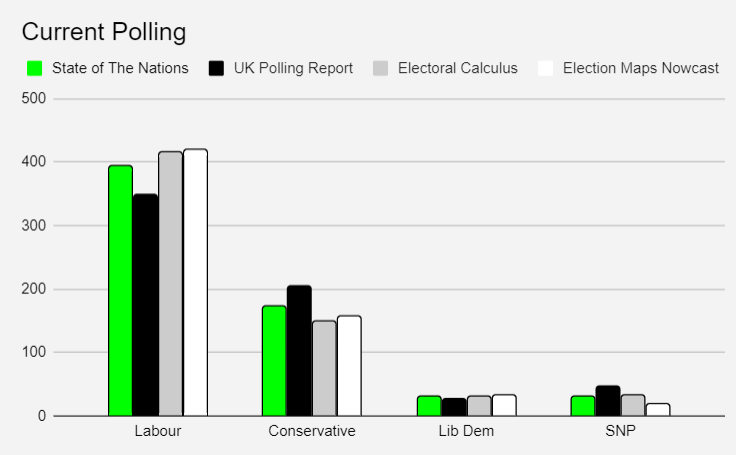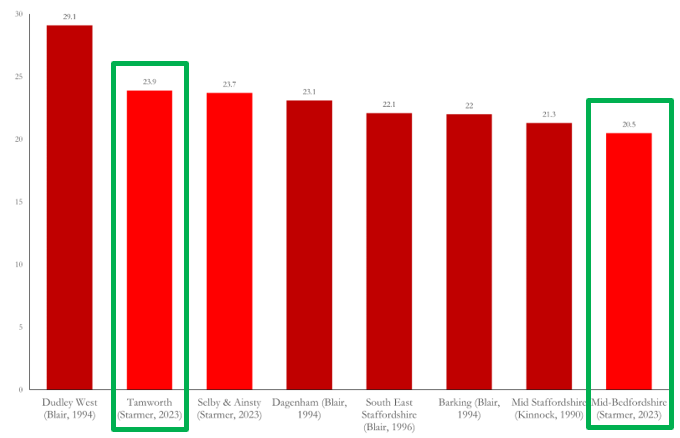Wargaming 2024 #2: 6 Months Out
Updated analysis and predictions for the 2024 general election.
The previous instalment was published six months ago, if you’d like to know how our predictions or arguments have changed, feel free to read it.
NB 24/05/2024: When we first wrote this series we assumed, like many, that the election date would be around October / November 2024. Seeing as Sunak has called a snap election, we’ve changed the dates of the title / in text references so they work as a legacy piece. All the text that isn’t time related has remained the same.
In Wargaming #1 (April 2023), after predicting a 70% chance of Labour majority government in 2024, we stated:
“Much may have changed [in six months time], but it’s unlikely the fundamentals will have shifted enough to trigger a complete reversal in predictions.”
We were perhaps being too cautious in our predictions, those such as Will Jennings would certainly argue so. But, if one remembers, the previous piece was published at the peak of the ‘Rishi Sunak or bust’ strategy, with successful foreign policy achievements in Northern Ireland and Ukraine. For a time there seemed a very small chance his presidential strategy may succeed. Our basic argument, though, was that any victory for the Conservatives was actually based on the economy returning to election winning form, as well as a high level of performance by Sunak in delivering his five pledges. Six months on, as this piece will show, neither of these conditions have been fulfilled.
The Data: Models, Polling and Fundamentals
There are several charts which, if taken alone, suggest a simple Labour victory at the next election. To start, here is an updated amalgamation of the most popular election models, of varying methods and debatable accuracy (Last taken from live / most recent models 27/10/23):1
Average (mean) seat predictions from most popular public election models:
Specific approval and issue polling again shows a picture of Tory pain. Ipsos, the most historically trusted pollster on approval ratings, has the headline here:
The ‘golden metrics’ which have accurately called each winner in every election since 1979 (who is best to run the economy? and who would be the best prime minister?) have also taken a decisive turn towards Keir Starmer and Labour.
Pollster Opinium, who uses a rigorous style of polling which weights more for Conservative style metrics in order to combat ‘answer bias’ of those more educated (Labour) voters which are more likely to answer polls, have Starmer leading in best PM polls:
On the economy, Starmer has consolidated his lead on who would be best to run the economy as YouGov’s long-term tracker shows:
What this adds up to is a substantial lead for Labour on polling metrics. However, it's best to treat polls as snapshots of what the electorate is feeling now and not predictions of what will occur in roughly six months' time. To paint a more accurate picture you need to analyse some of the fundamentals: governing competency, age and economic performance.
The economy has improved slightly, but has fallen short of the progress many expected. Inflation has fallen to 6.7%, but has become sticky over the last few months. Prices currently are still 15% higher than they were in November 2020, that's equivalent to seven years of low 2% inflation in just three years. The continually higher interest rates will also dampen any economic recovery. The effects on household disposable income and living standards has been, unsurprisingly, very negative. What's worse is Sunak’s pledge of halving inflation by the end of 2023 has become harder with geopolitical pressures in the middle east unlikely to be resolved and the price of oil expected to rise if all-out invasion of Gaza and escalation occurs. And it is important to remember that even as inflation decreases prices DO NOT – for that you need disinflation. So the electorate will still be feeling the squeeze even if inflation continues to fall into the new year.
After Wargaming #1 (April 2023), the UK economy grew slightly: 0.2% in Q2. However Q3 is looking bumpy, with a -0.6% contraction in July and only 0.2% growth in August. It is hardly the sustained growth the Chancellor needs for new spending increases or tax cuts. However, the recent ONS revision of growth statistics has shown that the UK’s economic performance has been better than previously realised, and the recovery since Covid puts us as good as, if not ahead of Germany and France. Another positive is that wages increased above inflation for the first time in two years, averaging 7.8%. But, overall, the outlook is not rosy – though there is room for further improvement. A possible silver lining is the debt repayment windfall, in theory offering around £20bn for possible stimulus policies. If the government U-turns towards neo-Keynesian stimulus, even in the form of tax cuts, it could pose a serious threat to Labour – especially as the UK economy seems more resilient than first predicted. Kate Andrew’s Recent Spectator article shows how the extra leg room in debt-repayments is ‘piling pressure’ on the Chancellor to introduce tax cuts from the right of the party.
Concerning governing age (14 years) and performance, there is not much to be said that hasn’t already. In short, the recent State of Play has you covered. But to summarise, the party has struggled to deliver anything substantive in the last four years, and is stuck in a toxic cycle of purge and churn. It will need a remarkable governing rally in the next year if it is to recover its reputation among the electorate and deliver key electoral issues: whether NHS waiting times, economic downturn or immigration numbers. It is highly unlikely considering the fractured state of the party.
Further Developments
Before giving our updated predictions its best to tackle some structural changes since our last Wargaming piece. Previously we cited work by Peter Kellner which suggested that, due to Labour's inefficient vote in First Past The Post electoral system, the Labour lead over the Tories would need to be as high as 12% to achieve victory. Since then, Kellner has published a remarkable analysis showing that, due to tactical voting, the lead may only need to be as small as 5%. This is highly significant. Because the Labour lead will naturally be squeezed closer to the election as apathetic traditional Tories return to the party, the Labour lead could become close – and fall short of that 12% previously thought needed for the 126 net gains necessary for a majority. However, with the bar now at just 5% it is much easier for Labour to win an outright majority, and means Tories cannot just consolidate their core vote to deny a Labour majority but now must actively switch those considering to vote Labour back to the party. Essentially, rather than settling on denying a Labour majority with 32-34% of the vote, the Tories will likely need to push beyond 35%+, which is a much trickier electoral task.
The other point also noted by Kellner, is that the recent by-election in Rutherglen and Hamilton West has confirmed the electoral shift in Scotland towards Labour. This makes the electoral maths for reaching 326 seats much easier for Starmer. If Scotland returns just 20 Labour seats, Starmer could cruise to Number 10. Return, say, 30, and the possibility of a Landslide becomes much higher. In short, what we are seeing in tactical voting and Scotland results in a switch in the FPTP rule: for the first time since 2010 it could start benefiting Labour again, a point that will no doubt annoy, and diminish, those in favour of proportional representation.
If these arguments weren’t enough, there are two other historical metrics flashing red on the Tory control panel. First, the historic by-election wins for Labour on October 19 in Mid Bedfordshire and Tamworth, which rank very highly in historical by-election swings.
As Rob Ford’s brilliant analysis shows, Labour are achieving over and above the necessary swing needed to win in 2024 – the required swing represented in the black bar. The recent average swings achieved by Labour are represented in the dark red bar:
A final statistical point is from Owen Winter, whose historical polling chart shows that Labour, in the current electoral time frame, are sustaining the leads an opposition must if it wants to win and form a government – and have been for well over a year:

The New Prediction
As a result, our (non-quantitative) predictions are as follows:
– 80% chance of Labour majority (+10)
– 15% chance of Labour minority (-5)
– 4% chance of Conservative minority (-4)
– 1% chance of Conservative majority (-1)
Where next?
With the current polling, models, fundamentals, FPTP changes and by-election performances it would be foolish to predict anything but a likely Labour majority. A landslide? That usually depends on the conditions closer to the time and emotions of the election day / night. However, it does seem, as Jim Callaghan astutely noted in 1979 before losing to Margaret Thatcher, that change is coming:
“You know there are times, perhaps once every 30 years, when there is a sea-change in politics. It then does not matter what you say or do. There is a shift in what the public wants and what it approves of. I suspect there is now such a sea-change – and it is for Mrs Thatcher.”
This series will pick up again next in May 2024, at which time we will likely know when the election will be (future TPI: in July!). There will be more economic fundamentals to analyse, as well as time for Conservative policy to play out, especially in the Autumn statement and Spring budget. It is possible that the Tories enjoy a better six months and therefore our predictions could become less assured, allowing more space for recovery in the form of a hung parliament. For now, however, it's hard to imagine how the Tories can cling to power as Starmer strolls to Number 10.
If you enjoyed the piece, a free subscription, like and share goes a long way. Thank you.
Tom Egerton is a political writer and researcher, his upcoming book ‘The Impossible Office: the history of the prime minister’ is out in February 2024, published by CUP and co-authored with Anthony Seldon. Follow him on X / Twitter here.
State of The Nations, Lab: 393 Con: 173 LD: 30 SNP: 30
UK Polling Report, Lab: 349 Con: 204 LD: 27 SNP: 47
Electoral Calculus, Lab: 416 Con: 149 LD: 30 SNP: 32
Election Maps Nowcast, Lab: 420 Con: 156 LD: 33 SNP: 18













